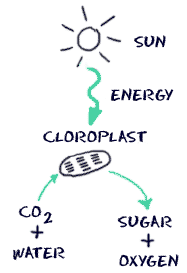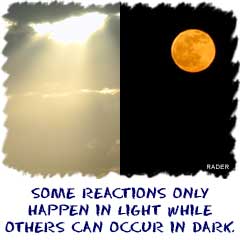

 Not all of the light from the Sun makes it to the surface of the Earth. Even the light that does make it here is reflected and spread out. The little light that does make it here is enough for the plants of the world to survive and go through the process of photosynthesis. Light is actually energy, electromagnetic energy to be exact. When that energy gets to a green plant, all sorts of reactions can take place to store energy in the form of sugar molecules.
Not all of the light from the Sun makes it to the surface of the Earth. Even the light that does make it here is reflected and spread out. The little light that does make it here is enough for the plants of the world to survive and go through the process of photosynthesis. Light is actually energy, electromagnetic energy to be exact. When that energy gets to a green plant, all sorts of reactions can take place to store energy in the form of sugar molecules.  The whole process doesn't happen all at one time. The process of photosynthesis is divided into two main parts. The first part is called the light dependent reaction. This reaction happens when the light energy is captured and pushed into a chemical called ATP. The second part of the process happens when the ATP is used to make glucose (theCalvin Cycle). That second part is called thelight independent reaction.
The whole process doesn't happen all at one time. The process of photosynthesis is divided into two main parts. The first part is called the light dependent reaction. This reaction happens when the light energy is captured and pushed into a chemical called ATP. The second part of the process happens when the ATP is used to make glucose (theCalvin Cycle). That second part is called thelight independent reaction.
| Roots: Take in water and food (mineral salts) from soil. Anchors plants. The roots of a plant are spread out. Stem:"Like a straw", transports water through plant. Raises the height of flowers and leaves. Brings closer to light. Structural. The stem is made up of little tubes. Leaves: Different shapes. Almost always green but sometimes covered with another colour such as red. Green substance in leaves -> chlorophyll. Leaves make food for the plant. To do this they need the water and mineral salts obtained from the soil. They are carried inside little veins in the leaf. To make food leaves also need sunshine and CO2. Flowers: Flowers produce seeds which form new plants. Space and warmth also needed for a plant to grow. |